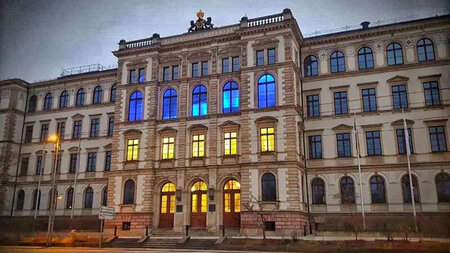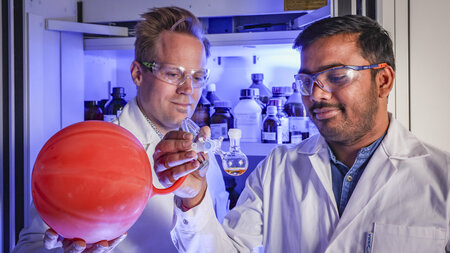Talks
| Speaker | Affiliation | Topic |
|---|---|---|
| Obinna Abah |
University of Augsburg, Germany |
Single ion heat engine with maximum efficiency at maximum power |
| Adolfo del Campo |
Los Alamos National Laboratory, USA |
Shortcuts to adiabaticity |
|
Andreas Fischer |
Chemnitz University of Technology, Germany |
Applied Endoreversible Thermodynamics: Controlling SI-Engines by the OptiVent-Cycle |
| Karl Heinz Hoffmann |
Chemnitz University of Technology, Germany |
A Dynamic View on the Third Law of Thermodynamics |
|
Ricardo Páez-Hernández |
Universidad Autónoma Metropolitana, Mexico |
|
|
Peter Salamon |
San Diego State University, USA |
|
|
Christian Schön |
Max-Planck Institute for Solid State Research, Germany |
|
|
Karsten Schwalbe |
Chemnitz University of Technology, Germany | |
|
Katharina Wagner |
Chemnitz University of Technology, Germany |
Modeling of chemical reactions and PEM fuel cells in Endoreversible Thermodynamics |
Single ion heat engine with maximum efficiency at maximum power
We propose an experimental scheme to realize a nanoheat engine with a single ion. An Otto cycle maybe implemented by confining the ion in a linear Paul trap with tapered geometry and coupling it to engineered laser reservoirs. The quantum efficiency at maximum power is analytically determined in various regimes. Moreover, Monte Carlo simulations of the engine are performed that demonstrate its feasibility and its ability to operate at a maximum efficiency of 30% under realistic conditions.
References:
[1] Single ion heat engine with maximum efficiency at maximum power
Shortcuts to adiabaticity
References:
[1] Fast frictionless dynamics as a toolbox for low-dimensional Bose-Einstein condensates
[2] Shortcuts to adiabaticity in a time-dependent box
[3] More bang for your buck:Towards super-adiabatic quantum engines
[4] Shortcuts to adiabaticity by counter-diabatic driving
[6] Quantum speed limits in open system dynamics
Applied Endoreversible Thermodynamics: Controlling SI-Engines by the OptiVent-Cycle
All energy transformation processes actually occurring are irreversible and often these irreversibilities must be respected in a realistic description of such processes. In particular, the proper quantification of the losses occurring in technologically relevant processes is an important goal. Endoreversible thermodynamics provides a non-equilibrium approach towards this goal by viewing a system as a network of internally reversible (endoreversible) subsystems exchanging energy in an irreversible manner. All irreversibilities are confined to the interaction between the subsystems. Although the performance limits of reversible processes like the Carnot efficiency provide valid upper bounds for real irreversible processes, real heat engines rarely attain more than a fraction of the reversible Carnot efficiency. Thus, reversible processes do usually not provide helpful guidance in the improvement of real processes.
The concept of ‘endoreversibility’ has proven to be a powerful tool for the construction of models with the desired qualities. Endoreversible systems basically are composed of internally reversible subsystems with (irreversible) interactions between them. The losses due to the finite times or rates of processes are located in the interactions alone. A proper modeling of the transport equations between the subsystems allows to quantify the dissipation associated with the energy exchange. The hypothesis of endoreversibility simplifies the expenditure for the analysis essentially. An important problem in the analysis of endoreversible systems is how to deal with the time dependence of process variables and parameters, i.e. how the dynamics of a system evolves during a process. Even though, this problem has first been investigated in relatively simple models, endoreversible thermodynamics as a general theory provides a framework to treat thermodynamical systems at all levels of detail and is thus a universal approach also ranging to very elaborate and complex models.
We here present an example of such a treatment. It is the analysis of a SI (spark ignition) engine, which is optimized in efficiency under the constraints given by CO2-emission commitments and legislation all over the world. The goal is to improve the efficiency of the SI engine significantly, while of course the exhaust emissions must not become worse. One recent approach towards this goal is the OptiVent cycle, a patented new way of controlling the mass air flow in the cylinder of a combustion engine using opening valves during the compression phase of a four stroke engine. This technology combines the gas exchange of a diesel engine and a combustion process of a spark ignition engine with its limits of air/fuel ratio. This way of operation regards a wider range of variability on the valvetrain components of the engine especially for opening the valves more than one time during a cycle. On the other hand it is necessary to combine this technology with direct injection to avoid fuel losses in the exhaust system and raising the exhaust hydrocarbon emission
of the engine. So it is a very complex technology but there are advantages in different fields especially using the fully variable valvetrain in future hybrids engine concepts. variable valve train on the exhaust valves of the engine. We present results from numerical simulations based on the endoreversible description of the OptiVent principle. These simulations show the potential of the new OptiVent-way of air mass control, thus enabling us to progress towards developing a running engine and putting it on a test bench.
References:
[1] Applied Endoreversible Thermodynamics: Controlling SI-Engines by the OptiVent-Cycle
A Dynamic View on the Third Law of Thermodynamics
Reversible thermodynamic processes are convenient abstractions of real processes, which are always irreversible. Approaching the reversible regime means to become more and more quasistatic, letting behind processes which achieve any kind of finite transformation rate for the quantities studied. On the other hand studying processes with finite transformation rates means to deal with irreversibilities and in many cases these irreversibilities must be included in a realistic description of such processes. Endoreversible thermodynamics is a non-equilibrium approach in this direction by viewing a system as a network of internally reversible (endoreversible) subsystems exchanging energy in an irreversible fashion. This material provides an introduction to the subject.
References:
[1] An Introduction to Endoreversible Thermodynamics
Dynamic properties in an endoreversible and non-endoreversible Curzon-Ahlborn engine considering the Van der Waals equation state
In this work we analyze the stability of an endoreversible Curzon–Ahlborn engine, using a van der Waals gas as working substance and the corresponding efficiency for such an engine. From the local stability analysis we find that a critical point of an almost linear system is stable. After arbitrary small perturbation, the system state exponentially decays to a critical point with either of two characteristic relaxation times that are a function of the thermal conductance (), heat capacity (C) and . The behavior of relaxation times and solution of the systems are shown qualitatively by sketching its phase portrait. Finally we discuss the local stability and steady state energetic properties of the endoreversible engine.
References:
[3] Thermodynamic performance vs. dynamic stability in an enzymatic reaction model
Optimal control in a quantum cooling problem
The optimal control for cooling a quantum harmonic oscillator by controlling its frequency is considered. It is shown that this singular problem may be transformed with the proper choice of coordinates to an equivalent problem which is no longer singular. The coordinates used are sufficiently simple that a graphical solution is possible and eliminates the need to use a Weierstrass-like approach to show optimality. The optimal control of this problem is of significance in connection with cooling physical systems to low temperatures. It is also mathematically significant in showing the power and limitations of coordinate transformations for attacking apparently singular problems.
References:
[1] Optimal control in a quantum cooling problem
Optimization of Chemical Processes
The optimization of chemical processes that take place in a finite time constitutes an important application of finite-time thermodynamics. In this study we investigate two generic optimal control problems for nucleation-and-growth based syntheses: the maximization of the amount of a crystalline solid phase generated via cooling from the melt within
a finite time τ , and the maximization of the difference between two metastable crystalline modifications again synthesized by crystallization from a supercooled melt. In both cases the optimal temperature program consists in a bangbang solution with constant values of the temperature, where a switch from a temperature T1, where nucleation rates are high, to a temperature T0 > T1, where the growth rates of the crystallites are maximal, occurs. The location of the switching time ts*, 0 ≤ ts* ≤τ , is analyzed as function of the parameters of the models describing the chemical systems, and an application to the synthesis of glycerol crystals is given.
References:
[1] Optimization of Chemical Processes
Recuperation Systems in Vehicles - Endoreversible Modeling of a bladder accumulator and a lithium ion battery
The theory of Endoreversible Thermodynamics has proven as an important tool to investigate thermodynamic systems in the last decades. The focus of research activities was mostly on systems with only heat and/or (diffusion based) particle transport. However hydraulic, electrical and electrochemical systems are of great interest concerning, for example, energy storage and supply devices like bladder accumulators, supercaps, fuel cells and batteries. A bladder accumulator can be used, for instance, to convert the kinetic energy of vehicles into ‚hydraulic energy‘. Such recuperation processes have emerged to be an important issue concerning new vehicle concepts. In the first part of my talk I want to speak about an endoreversible model of such a hydraulic recuperation system.
Alternatively, kinetic energy of vehicles can be stored in a battery. Therefore, a first approach towards an endoreversible lithium ion battery model will be presented in the second part of my talk. In the model fundamental transport processes like the ohmic transport of electrons, the diffusion and migration of ions and the Butler-Volmer kinetics are considered. Using this model the theoretical behavior of the battery under different working conditions can be investigated. These results allow the optimization of different working characteristics like power or efficiency.
Modeling of chemical reactions and PEM fuel cells in Endoreversible Thermodynamics
The first part of the talk contains an approach to model chemical reactions in the realm of Endoreversible Thermodynamics and the treatment of mass fluxes instead of pure entropy or particle fluxes. The second part is the application of Endoreversible Thermodynamics to proton exchange membrane fuel cells. The chemical reactions at the anode and cathode as well as dissipation in the membrane are included in the model. With the help of the model different quantities, e.g. power output and entropy production, are investigated.





